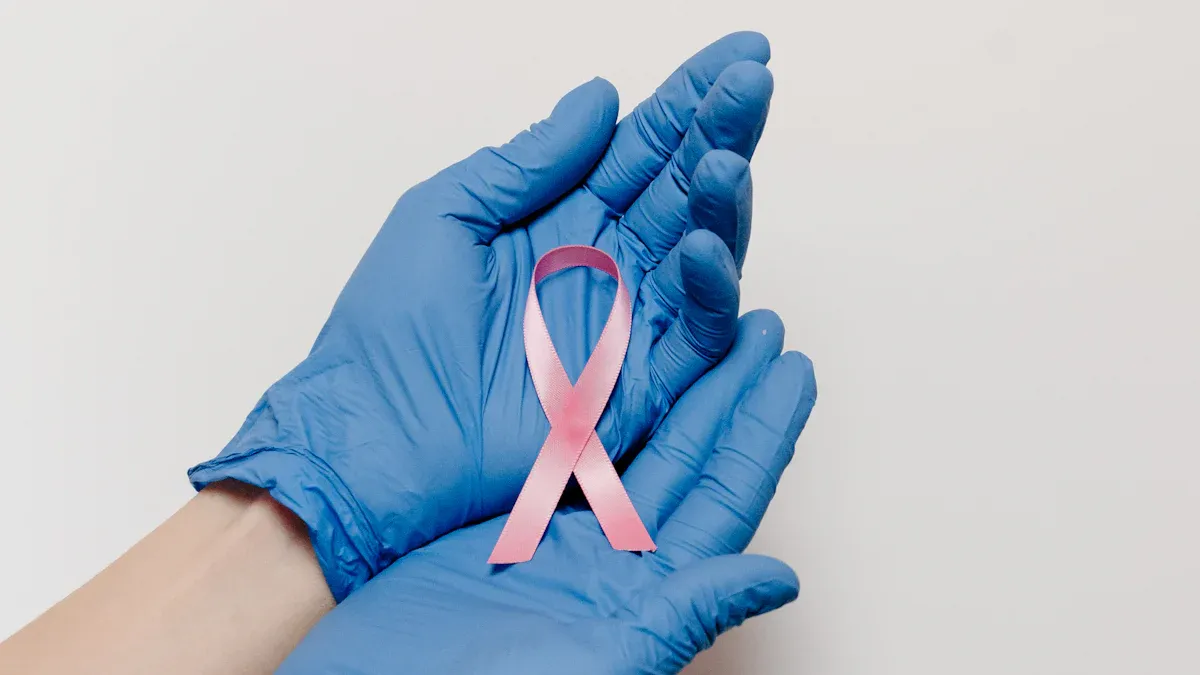Understanding AIDS Related Lymphoma

AIDS related lymphoma refers to specific types of lymphoma that occur more frequently in individuals with HIV/AIDS. These cancers develop due to a weakened immune system caused by the virus. The most common type is diffuse large B-cell lymphoma (DLBCL), accounting for about 50% of HIV-related lymphomas. Other types include Burkitt lymphoma (10%), plasmablastic lymphoma (2%), and Hodgkin lymphoma, which represents 5% of cancers in people with HIV.
Type of Lymphoma | Prevalence Rate |
|---|---|
Diffuse large B-cell lymphoma | ~50% of HIV-related lymphomas |
Plasmablastic lymphoma | ~2% of HIV-related lymphomas |
Burkitt lymphoma | ~10% of HIV-related lymphomas |
Hodgkin lymphoma | ~5% of cancers in people with HIV |
Understanding these types can help you recognize symptoms early and seek timely treatment.
Key Takeaways
AIDS related lymphoma happens more often in people with HIV. This is because their immune system is weaker. Finding symptoms early helps start treatment sooner.
The most common type of AIDS related lymphoma is called Diffuse Large B-Cell Lymphoma (DLBCL). It makes up about half of all cases. Symptoms include swollen glands, fever, and sweating at night.
Treating HIV with antiretroviral therapy (ART) makes lymphoma treatments work better. ART helps the immune system stay stronger, which improves recovery.
Chemotherapy is a main treatment for AIDS related lymphoma. It is often used with special medicines like rituximab. Talk to your doctor to find the best treatment plan for you.
Getting emotional support is very important during treatment. You can join support groups or talk to a counselor to handle the stress of having cancer.
Types of AIDS Related Lymphoma

Diffuse Large B-Cell Lymphoma (DLBCL)
Symptoms of DLBCL
You may notice symptoms such as swollen lymph nodes, fever, night sweats, or unexplained weight loss if you have Diffuse Large B-Cell Lymphoma (DLBCL). These symptoms often appear suddenly and progress quickly. Some individuals also experience fatigue or abdominal pain due to enlarged organs.
Diagnostic Methods for DLBCL
Doctors use a combination of imaging tests, biopsies, and blood work to diagnose DLBCL. A biopsy of the affected lymph node is the most definitive method. In individuals with HIV/AIDS, DLBCL exhibits unique molecular features. For example, mutations like EZH2 and CD79A/B, common in other cases, are often absent. This difference highlights the need for specialized diagnostic approaches.
Burkitt Lymphoma
Symptoms of Burkitt Lymphoma
Burkitt Lymphoma progresses rapidly and may cause noticeable swelling in the abdomen, jaw, or neck. You might also experience severe abdominal pain, nausea, or vomiting. Fever and night sweats are common as well.
Diagnostic Methods for Burkitt Lymphoma
Doctors often rely on imaging tests, biopsies, and bone marrow analysis to confirm Burkitt Lymphoma. This type of AIDS related lymphoma is about 30 times more common in individuals with HIV than in the general population. Early diagnosis is crucial due to its aggressive nature.
Primary CNS Lymphoma
Symptoms of Primary CNS Lymphoma
Primary CNS Lymphoma (PCNSL) often presents with neurological symptoms. You might experience headaches, confusion, memory loss, or seizures. Focal neurological deficits, such as weakness in one part of the body, are also common.
Diagnostic Methods for Primary CNS Lymphoma
Doctors use imaging techniques like MRI to identify lesions in the brain. Most cases of PCNSL are associated with Epstein-Barr virus (EBV). Diagnosis often requires a biopsy to distinguish it from other conditions like cerebral toxoplasmosis. This type of lymphoma is an AIDS-defining illness and accounts for up to 15% of non-Hodgkin lymphomas in HIV patients.
Hodgkin Lymphoma
Symptoms of Hodgkin Lymphoma
Hodgkin Lymphoma often presents with symptoms that can be mistaken for other illnesses. You might notice painless swelling in the lymph nodes, particularly in the neck, armpits, or groin. Fever, night sweats, and unexplained weight loss—commonly referred to as B symptoms—are also frequent. Fatigue and persistent itching may occur as well.
In individuals with HIV/AIDS, Hodgkin Lymphoma tends to behave more aggressively. You are more likely to experience extranodal involvement, such as in the bone marrow, rather than just the lymph nodes. Mediastinal adenopathy, which is common in non-HIV cases, occurs less frequently. The disease often appears with histological subtypes like mixed cellularity or lymphocyte-depleted Hodgkin Lymphoma. Reed-Sternberg cells, a hallmark of this cancer, frequently express Epstein-Barr virus (EBV) proteins. If your CD4 count is below 300/dL, you may face a higher risk of developing this condition.
Tip: If you experience persistent B symptoms or swollen lymph nodes, consult a healthcare provider promptly. Early detection can improve outcomes.
Diagnostic Methods for Hodgkin Lymphoma
Doctors use several methods to diagnose Hodgkin Lymphoma. A biopsy of the affected lymph node is the most reliable way to confirm the disease. Pathologists examine the tissue for Reed-Sternberg cells, which are a key indicator. Imaging tests, such as CT or PET scans, help determine the extent of the disease. Blood tests may also reveal abnormalities, including low red blood cell or platelet counts.
In HIV-associated cases, doctors pay close attention to extranodal sites like the bone marrow. They may perform a bone marrow biopsy if they suspect involvement. Identifying the subtype of Hodgkin Lymphoma is crucial for tailoring treatment.
AIDS related lymphoma, including Hodgkin Lymphoma, requires specialized care. Understanding the unique characteristics of this condition in HIV-positive individuals can guide effective diagnosis and treatment.
Why HIV Increases the Risk of AIDS Related Lymphoma
Weakened Immune System
HIV weakens your immune system by targeting CD4+ T cells, which play a critical role in defending your body against infections. As the virus destroys these cells, your immune system becomes less effective. This depletion also disrupts the function of other immune cells, such as B cells, which are responsible for producing antibodies. Without proper immune regulation, your body struggles to fight off infections and abnormal cell growth.
HIV reduces the number of CD4+ T cells, leaving your immune system vulnerable.
Impaired B cell function increases the risk of developing lymphomas.
Certain infections, like those caused by Epstein-Barr virus (EBV), become more likely and contribute to lymphoma development.
This weakened immune state creates an environment where cancerous cells can grow unchecked, increasing your risk of AIDS related lymphoma.
Chronic Inflammation and Viral Infections
When your immune system is constantly fighting HIV, it remains in a state of chronic inflammation. This prolonged inflammation damages tissues and alters the way your immune cells function. Over time, these changes can lead to genetic mutations in cells, which may result in cancer.
Additionally, HIV makes you more susceptible to viral infections that can trigger lymphoma. For example, viruses like EBV and human herpesvirus 8 (HHV-8) are known to promote cancer development. Chronic inflammation combined with these viral infections creates a perfect storm for lymphoma to develop.
Co-infection with Epstein-Barr Virus (EBV)
If you are co-infected with HIV and EBV, your risk of developing lymphoma increases significantly. Studies show that individuals with both infections have over a 60-fold higher risk of lymphoma compared to the general population. HIV weakens your immune system, allowing EBV to replicate more aggressively. This leads to higher levels of the virus in your blood and tissues.
EBV also activates CD8+ T cells, which can further disrupt your immune balance. This combination of immune dysfunction and viral activity creates conditions that promote the growth of EBV-associated lymphomas. Understanding this connection highlights the importance of managing both HIV and EBV to reduce your cancer risk.
Treatment Options for AIDS Related Lymphoma

Chemotherapy and Antiretroviral Therapy (ART)
Chemotherapy remains a cornerstone in treating AIDS related lymphoma. With the advent of highly active antiretroviral therapy (HAART), you can now safely undergo standard or even intensive chemotherapy regimens. Studies show that combining chemotherapy with rituximab improves outcomes, including higher complete response rates and longer survival. For example, infusional EPOCH chemotherapy has demonstrated better results compared to CHOP in many cases. However, the timing of HAART with chemotherapy can vary. Some experts recommend starting HAART after chemotherapy, while others suggest concurrent use. Your healthcare team will tailor the approach based on your specific needs.
Targeted Therapy and Immunotherapy
Targeted therapy and immunotherapy offer promising options for treating lymphoma. These treatments focus on attacking cancer cells while sparing healthy ones. Rituximab, a monoclonal antibody, targets CD20 proteins on B cells and is often used alongside chemotherapy. This combination enhances the effectiveness of treatment. Immunotherapy, such as immune checkpoint inhibitors, helps your immune system recognize and destroy cancer cells. These therapies are particularly beneficial if you have relapsed or refractory lymphoma. Discussing these options with your doctor can help you understand how they fit into your treatment plan.
Managing Opportunistic Infections During Treatment
During lymphoma treatment, your immune system may become weaker, increasing the risk of infections. Prophylactic measures, such as antibiotics, antiviral medicines, and antifungal medications, can help prevent infections. Monitoring for dormant infections is also essential, especially if your CD4+ T cell count is low. Rapid recognition and treatment of any new infections are critical. In some cases, doctors may recommend G-CSF injections to boost your white blood cell count. Additionally, continuing HAART during treatment supports your immune system and reduces the risk of opportunistic infections.
Tip: Staying vigilant about infection prevention and promptly reporting symptoms to your doctor can improve your overall treatment experience.
The Role of HIV Management in Lymphoma Treatment
Managing HIV effectively plays a critical role in improving lymphoma treatment outcomes. When you control HIV with antiretroviral therapy (ART), your immune system becomes stronger, which enhances the effectiveness of lymphoma treatments. ART helps stabilize your CD4+ T cell count, allowing your body to better tolerate chemotherapy and other cancer therapies.
Patients with well-managed HIV often experience fewer side effects during lymphoma treatment. This is because ART reduces the viral load in your body, lowering the risk of complications like opportunistic infections. Doctors typically recommend continuing ART alongside lymphoma treatment to maintain immune function and support recovery.
Effective HIV management enhances the success of lymphoma therapies.
Patients on ART experience fewer side effects during cancer treatment.
Controlling HIV improves your ability to fight infections and recover faster.
Coordination between HIV and lymphoma treatments is essential for optimizing outcomes. You will likely receive the same lymphoma therapies as someone without HIV, but your doctor will consider additional factors, such as potential drug interactions and side effects. For example, some chemotherapy drugs may suppress your immune system further, so your healthcare team will monitor you closely to prevent complications.
By managing HIV effectively, you create a foundation for successful lymphoma treatment. This approach not only improves your overall health but also increases the likelihood of achieving remission. If you have AIDS related lymphoma, prioritizing HIV management can make a significant difference in your treatment journey.
Managing Health and Emotional Well-Being
Physical Self-Care During and After Treatment
Infection Prevention and Immune Support
Your immune system becomes more vulnerable during and after treatment for AIDS related lymphoma. Taking steps to prevent infections is essential. Wash your hands frequently and avoid close contact with individuals who are sick. Vaccinations, such as the flu shot, can provide additional protection. Your doctor may also recommend prophylactic medications to prevent opportunistic infections. Staying consistent with antiretroviral therapy (ART) strengthens your immune system and reduces the risk of complications.
Nutrition and Exercise
Proper nutrition plays a vital role in your recovery. Malnutrition is a known risk factor for poor outcomes in individuals with HIV-associated lymphoma. Eating a balanced diet rich in fruits, vegetables, lean proteins, and whole grains can improve your overall health and resistance to disease. If you are at risk of malnutrition, consult a dietitian for tailored nutritional support. Exercise, even light activities like walking, can boost your energy levels and improve your mood. Always discuss your exercise plan with your healthcare provider to ensure it aligns with your treatment and recovery needs.
Emotional and Mental Health Support
Coping with a Cancer Diagnosis
Receiving a diagnosis of AIDS related lymphoma can feel overwhelming. You may experience a range of emotions, including fear, sadness, or anger. Seeking psychological support can help you navigate these feelings. Group counseling and one-on-one therapy sessions with trained professionals provide a safe space to express your concerns. These services can also help you develop coping strategies to manage stress and anxiety.
Support Groups and Counseling
Support groups connect you with others who understand your experiences. Local groups and online forums, such as those offered by Lymphoma Action, provide emotional and psychological support. HIV clinics often have information on counseling services and helplines. Social workers can assist with financial concerns related to treatment. These resources help you feel less isolated and more empowered to face challenges.
Long-Term Health Monitoring and Follow-Up Care
After completing treatment, follow-up care becomes a critical part of your health journey. Your doctor will schedule regular appointments to monitor for any recurrence of lymphoma. These visits may include physical exams, blood tests, and imaging studies. Repeating diagnostic tests helps assess your progress and ensures that any signs of cancer returning are caught early. Staying consistent with follow-up care allows your healthcare team to make informed decisions about your long-term health.
AIDS related lymphoma is a serious condition, but with timely diagnosis and proper care, you can achieve better outcomes. Early treatment significantly improves survival rates. For example, individuals in the good prognosis group have a median survival time of 11.3 months, while the 2-year overall survival rate is 35%.
Support organizations can guide you through this journey. Resources like Lymphoma Action and Blood Cancer UK offer helplines and peer support. NYU Langone Health provides integrative therapies, such as massage and acupuncture, to ease treatment side effects. Connecting with these services ensures you receive both medical and emotional support.
Note: Seeking medical advice promptly and utilizing available resources can make a significant difference in your recovery.
FAQ
What is the connection between HIV and lymphoma?
HIV weakens your immune system, making it harder to fight infections and abnormal cell growth. This increases your risk of developing lymphoma, especially types like Diffuse Large B-Cell Lymphoma and Burkitt Lymphoma. Managing HIV with antiretroviral therapy (ART) reduces this risk.
Can AIDS related lymphoma be cured?
Yes, treatment can lead to remission. Chemotherapy, targeted therapy, and ART improve outcomes. Early diagnosis and proper care increase your chances of recovery. Discussing your treatment options with your doctor ensures the best approach for your condition.
How can you recognize the symptoms of AIDS related lymphoma?
Look for swollen lymph nodes, fever, night sweats, and unexplained weight loss. Neurological symptoms like headaches or confusion may indicate Primary CNS Lymphoma. If you notice these signs, consult your doctor immediately.
Is it safe to undergo chemotherapy while on ART?
Yes, combining chemotherapy with ART is safe and effective. ART strengthens your immune system, helping you tolerate cancer treatments better. Your doctor will monitor for drug interactions and adjust your treatment plan as needed.
What lifestyle changes can help during treatment?
Focus on a balanced diet, regular exercise, and infection prevention. Wash your hands often and avoid contact with sick individuals. Staying consistent with ART and attending follow-up appointments also supports your recovery.
Tip: Always communicate openly with your healthcare team about any symptoms or concerns during treatment.
See Also
Understanding Acute Biphenotypic Leukemia In Layman's Language
